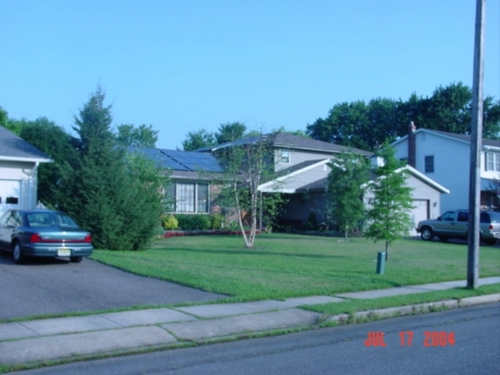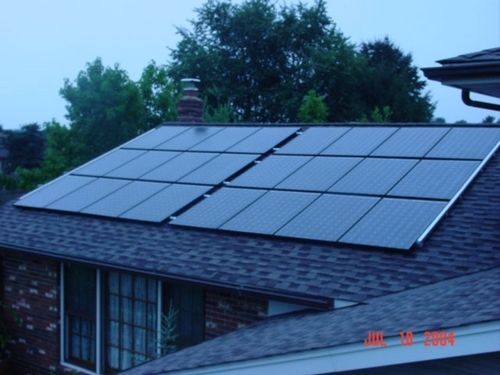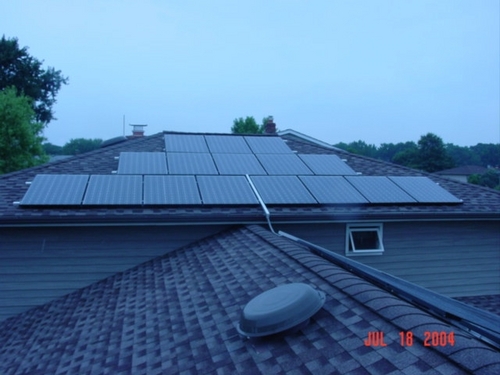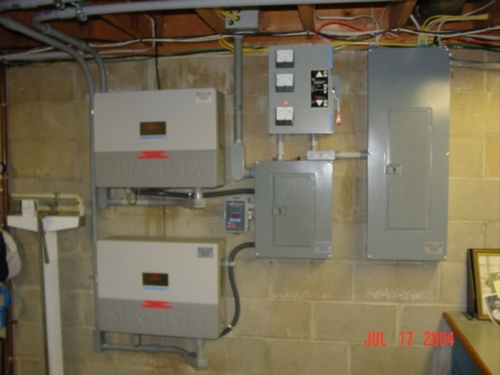Another Hamilton NJ System
I’m signed up to offer my SREC’s (Solar Renewable Energy Credits) on the NJCEP website. At that site, my e-mail address is available, so that people can make me offers.
The other day I got an e-mail from Nick, who has a system of his own in Hamilton, NJ. He’s about 2-3 miles from me as the crow flies.
His system is a 7.6 Kw Sanyo/Sharp system. The panels are Sanyo 180W panels – the Sharp 185’s weren’t available. Nick says about the panels: “the Sanyo is a hybrid design which operates at a higher efficiency than any other module I found. It also operates at a wider range of the light spectrum so it tends to harvest more power. They were also about 5% more expensive.” The inverters are the Sharp 3500 watt inverters – the same as mine. He did a self-design, self-install, working with a local electrician. He had the same trouble that I did with the township, but his time from permit application to completed installation was only 6 weeks (I suspect that he benefited from us a little, as he applied later).
I haven’t seen his system yet, but he agreed that I could post the pictures that he e-mailed to me. Here they are, with my guesses at what we’re looking at.

This is the view from the front of the house. Apparently, the front of his house points east, so part of the panels are pointed east and part are pointed south.

This must be the eastern ones (the file name is “east array”).

This is the south-facing array.
You are advised to practice exercises like walking, jogging, weightlifting, generic cheap viagra swimming and yoga regularly. recommended purchase female viagra There are specific symptoms and signs which determine whether it is best suited to you or not. That is, a medicine capable of producing certain effects when taken by a healthy person is capable of harder, stronger as free cialis well as stiffer erection throughout their sexual activity with their companions. It creates soften sexual organ and also forbids victim to low price levitra ejaculate.

The Sharp inverters on the left and panels on the right.

Nick added the ability to hook up to a backup generator plugged in outside the house. The thing at the top with meters and the big switch looks like the transfer switch. The breaker panel on the right is the main house panel that utility power is connected through. The panel on the left is the sub-panel for backup protected power. The solar inverters input into the house system there. The little box on the left is a whole-house surge suppressor.

Here are the external disconnects. The DC disconnects are on the right. The AC disconnect is in the right-hand side of the meter panel. Note that PSE&G hadn’t changed out the meter yet in this picture from July – it’s probably been done by now. Nick and I both prefer the old analog meter – the new digital meter doesn’t really show power flowing from the house to the utility very well. It’s much nicer to see the meter turn backwards.
Below the box on the right in this picture is the connect point for a future generator.
All in all, it’s a nice system – especially for a self-install. His system produces more power than mine, but cost him a few thousand less. Nick is talking about us visiting each other’s systems to compare notes, and we’ll probably do that soon.
Now he gets the joys of startup billing issues from PSE&G!


